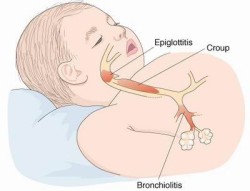Croup is commonly related to signs of respiratory infection. It is the infection of the larynx and the trachea, also known as the voice box and windpipe, respectively. It is a common malady of children, especially between the ages of three months and six years of age. However, its peak is said to be at two years of age.
Croup will generally last from five to six days, with symptoms most severe during the first two nights. Because it is commonly caused by viral infections, it is highly contagious to other children, as airborne droplets from an infected child’s cough may come in contact with other children. Most cases are considered mild and can be treated at home. However, in severe cases, hospitalization may be required. There have been cases of recurring croup among children.
Cause of Croup
There are different causes for croup. Some of the following include:
- Breathing infected air or touching contaminated things
- Viral infection (most common)Commonlaused by parainfluenza viruses
- Respiratory Syncytial Virus (RSV), measles, influenza and adenovirus
- Bacterial infectionDiphtheria bacteria
- Allergic reactions
- Acid reflux
- Inhaling in foreign body that irritates airway
Symptoms of Croup
The first and most obvious symptom of croup is a cough, similar to that of a barking dog or seal, thus it is called a “barking” cough. Symptoms are often worst at night. The following are the less evident symptoms
- Breathing difficulty and noisilyDue to inflammation of tissue surrounding the larynx, resulting to a constricted windpipe
- Also due to blocking of bronchial passages with mucus
- Noise is due to coercing of air through the narrowed airways producing a stridor, a raspy noise, during inspiration
- Mild cold before onset of barking cough
- Hoarse voice
- Fever

Treatment for Croup
Children are especially prone to croup due to their small trachea and susceptible bronchial passages. As previously mentioned, croup can be managed at home. There is rarely a need for aggressive treatment.
- Steam therapy or cool moist to dissolve the sticky mucus and ease breathing passageway and lubricate the larynx and trachea
- If croup is caused by bacteria, antibiotics will be given. However, it will not be advised for viral infections.
- If symptoms persist beyond three days, oral corticosteroids may be prescribed to decrease swelling and inflammation. Epinephrine may also be prescribed, although, effects do not last as long.
As a fairly common condition occurring for children, understanding croup may help when taking first aid courses, especially in topics related to respiratory problems.
